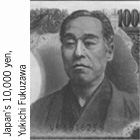|
Japan's printing bureau describes their selection process:
1. We conducted an investigation in 1980 concerning whose portraits would be
appropriate to be printed on the Japanese banknotes. The names of scholars, artists,
and other famous intellectual persons received high major scores, and it was finally
decided that these categories of people would be the most accepted by the general
public.
|

|
|
2. We examined recent cases when banknotes were revised in several countries
overseas. As a result, we understood that there was a common tendency to have used
the portrait of famous intellectual persons whom people were proud of in their countries.
|
3. It is desirable to obtain precise photographs of the persons concerned both from the
viewpoint of counterfeit prevention and from that of the portrait engraving process.
4. The persons selected should be well known such as those who are introduced
through education textbooks and should be those who are welcomed by the general
public.
|
|
Yukichi Fukuzawa (10,000 yen), a 'famous profound thinker' in the period from the late Edo Era to the early Meiji
Era and one of the founders of Keio University; Inazo Nitobe (5,000 yen) is a famous Meiji Era educator and
later played a role in the League of Nations and Soseki Natsume (1,000 yen) who is a famous Meiji Era
novelist. All three, belonging to the Meiji period during which Japan underwent an extensive cultural
modernization, contributed to the transformation by helping to bridge some of the cultural differences
between traditional Japan and Western cultures.
|
 Writer, musician, painter, engineer and scientists
th figure for their contribution to the 20th century
consiousness Débussy, Saint-Exupéry, Cézanne, Eiffel, Pierre et
Marie Curie.
Writer, musician, painter, engineer and scientists
th figure for their contribution to the 20th century
consiousness Débussy, Saint-Exupéry, Cézanne, Eiffel, Pierre et
Marie Curie.
|
|
Even at times the person’s sex becomes a criteria. Germany specifies:
The main motifs on the notes are portraits of major figures in German
cultural and intellectual life from the 17th to the early 20th century.
|
Indeed, the sex becomes an important element as the final selection is
even: the 5 Deutch Mark shows a woman writer (Bettina von Arnim),the 10 DM is a male astronomer (Carl Friedrich Gauss), the 20 DM is Annette von Droste-Hülshoff, a poetess, every note alternating between a man and a woman.
|

 Writer, musician, painter, engineer and scientists
th figure for their contribution to the 20th century
consiousness Débussy, Saint-Exupéry, Cézanne, Eiffel, Pierre et
Marie Curie.
Writer, musician, painter, engineer and scientists
th figure for their contribution to the 20th century
consiousness Débussy, Saint-Exupéry, Cézanne, Eiffel, Pierre et
Marie Curie.


